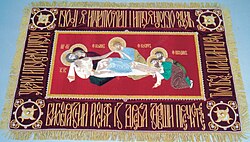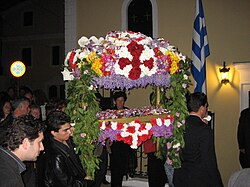Good Friday
Good Friday is a religious holiday usually observed by Christians. It is also called Holy Friday, Black Friday, or Great Friday. It is observed to remember the crucifixion of Jesus Christ, his death, and his rising from the dead. The holiday is often at the same time as the Jewish holiday of Passover.
| Good Friday | |
|---|---|
| Type | Christian |
| Significance | Remembers the crucifixion and death of Jesus Christ |
| Date | Friday immediately preceding Easter Sunday |
| Celebrations | No traditional celebrations |
| Observances | Prayer and vigil services, fasting, giving money to the poor |
| Related to | Passover, Christmas, Easter Sunday |
The estimated year of Good Friday is AD 33, by two different groups, and at first as AD 34 by Isaac Newton by the differences between the Biblical and Julian calendars.[1][2][3][4]
Biblical account

According to the Gospels, Jesus was arrested in the Garden of Gethsemane by the Temple Guards. This was done through the help of his disciple Judas Iscariot. Judas received money (30 pieces of silver) (Matthew 26:14-16) for betraying Jesus. He had told the guards that whomever he kisses was the one they were to arrest. Jesus was brought to the house of Annas. Annas was the father-in-law of the high priest at that time, Caiaphas. There he was questioned. However, it was with little result. Tied up, he was sent to Caiaphas the high priest, where the Sanhedrin had come together (John 18:1-24).
Lots of people came and said conflicting things about Jesus to make him look bad. As he heard these, Jesus said nothing. At last, the high priest tells Jesus, "I adjure you, by the Living God, to tell us, are you the Anointed One, the Son of God?" Jesus said yes: "You have said it, and in time you will see the Son of Man seated at the right hand of the Almighty, coming on the clouds of Heaven." The high priest ripped his clothes, crying out that Jesus had blasphemed God. The trial ended with a sentence of death (Matthew 26:57-66). While they were questioning Jesus, Peter was waiting in the courtyard. He also said that he did not know Jesus three times to people standing by. According to the Bible, Jesus already knew that Peter would say this.
In the morning, the people brought Jesus to the Roman governor Pontius Pilate. They said he was troubling the nation. They also said he tried to stop people from paying taxes to Caesar, and wanted to make himself a king (Luke 23:1-2). Pilate questioned Jesus. He told the people that Jesus had nothing to be sentenced for. When he learned that Jesus was from Galilee, Pilate said that Jesus should be judged by the ruler of Galilee, King Herod. At that time, Herod was in Jerusalem for the Passover Feast. Herod questioned Jesus, but Jesus did not answer. Herod sent Jesus back to Pilate. Pilate told the people that neither he nor Herod have found Jesus guilty. Pilate wished to have Jesus whipped, then let him go (Luke 23:3-16).
It was a custom during the feast of Passover for the Romans to let one prisoner go free as requested by the Jews. Pilate asked the crowd whom they would like to go free. The crowd asked for Barabbas, another prisoner. He had gone to prison for murdering people. Pilate asked what they would have him do with Jesus. At this, and they demanded, "Crucify him!" (Mark 15:6-14). Pilate's wife warned Pilate to "have nothing to do with this righteous man" (Matthew 27:19). She had had a dream about him earlier that day.
Pilate had Jesus whipped, then tried to let him go. The chief priests demanded that Jesus be sentenced to death "because he claimed to be God's son." This filled Pilate with fear. He brought Jesus back inside the palace and demanded to know from where he came (John 19:1-9).
Coming before the crowd one last time, Pilate declared Jesus innocent. He washed his own hands in water to show he has no part in this. However, Pilate handed Jesus over to be crucified so that the crowd would not get angry (Matthew 27:24-26) and that he could keep his job. Jesus carried his cross to "A Place of the Skull", or "Golgotha" in Hebrew. In Latin it is called "Calvary". There he was crucified with two criminals (John 19:17-22).
Jesus is hung on the cross for six hours in extreme pain. During his last 3 hours on the cross there is darkness over the whole land (Matthew 27:45; Mark 15:13; Luke 23:44). At last, Jesus cried, "It is finished". He then "gave up his spirit". There is an earthquake. Tombs break open, and the curtain in the Temple is torn from top to bottom. The centurion on guard at the crucifixion declares, "Truly this was God's Son!" (Matthew 27:45-54)
Joseph of Arimathea, a member of the Sanhedrin and secret follower of Jesus, who had not said yes to his death, went to Pilate. He asked for the body of Jesus (Luke 23:50-52). Another secret follower of Jesus and member of the Sanhedrin named Nicodemus brought a mix of spices and helped wrap the body of Christ (John 19:39-40). Pilate asked the centurion to make sure that Jesus is dead (Mark 15:44). A soldier pierced the side of Jesus, causing blood and water to flow out (John 19:34). At this, the centurion told Pilate that Jesus was dead (Mark 15:45).
Joseph of Arimathea took the body of Jesus, wrapped it in a clean linen shroud, and placed it in his own new tomb that had been carved in the rock (Matthew 27:59-60). The tomb was in a garden. Nicodemus (John 3:1) also came bringing 75 pounds of myrrh and aloes, and placed them in the linen with the body of Jesus, according to Jewish burial customs (John 19:39-40). They rolled a large rock over the entrance of the tomb (Matthew 27:60). Then they went back home and rested, because at sunset began Shabbat (Luke 23:54-56). According to the Bible, on the third day, Sunday, which is now known as Easter Sunday (or Pascha), Jesus rose from the dead.
Celebration
Special prayer services are usually held on this day with readings from the Gospel accounts of the events leading up to the crucifixion. Major Christian churches say that Christ's crucifixion was a voluntary act that he did for everyone who believed in him. It is also said that his crucifixion and resurrection on the third day caused death itself to be crushed.
Good Friday Media
The Judas Kiss by Gustave Doré, 1866
Good Friday cross from the Catholicon at Holy Trinity Monastery, Meteora, Greece
The crucified Christ, just before the Deposition from the Cross and the placing of the Epitaphios in the Sepulchre
The epitaphios ("winding sheet"), depicting the preparation of the body of Jesus for burial
The Epitaphios being carried in procession in a church in Greece
Related pages
References
- ↑ Isaac Newton, 1733, Of the Times of the Birth and Passion of Christ, in "Observations upon the Prophecies of Daniel and the Apocalypse of St. John" (London: J. Darby and T. Browne).
- ↑ Bradley Schaefer, 1990, Lunar Visibility and the Crucifixion Quarterly. Journal of the Royal Astronomical Society 31.
- ↑ "Astronomers on the Date of the Crucifixion". Archived from the original on 25 April 2011. Retrieved 2 April 2010.
- ↑ John Pratt Newton's Date For The Crucifixion "Quarterly Journal of Royal Astronomical Society", September 1991.
Other websites
- The Eastern Orthodox commemoration of the holiday Archived 7 June 2011 at the Wayback Machine
- Episcopal Good Friday Service
- Good Friday hymns at St-Takla.org








